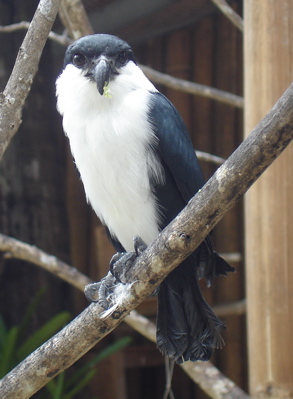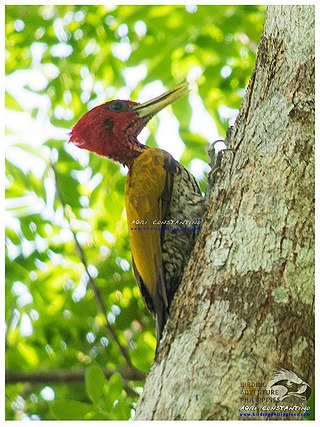
The Eurasian collared dove, collared dove or Turkish dove is a dove species native to Europe and Asia; it was introduced to Japan, North America and islands in the Caribbean.

The black francolin is a gamebird in the pheasant family Phasianidae of the order Galliformes. It was formerly known as the black partridge. It is the state bird of Haryana state, India. Fried black francolin is eaten in Azerbaijani cuisine.

The spotted dove or eastern spotted dove is a small and somewhat long-tailed pigeon that is a common resident breeding bird across its native range on the Indian subcontinent and in Southeast Asia. The species has been introduced to many parts of the world and feral populations have become established.

The laughing dove is a small pigeon that is a resident breeder in Africa, the Middle East, South Asia, and Western Australia where it has established itself in the wild after being released from Perth Zoo in 1898. This small long-tailed dove is found in dry scrub and semi-desert habitats where pairs can often be seen feeding on the ground. It is closely related to the spotted dove which is distinguished by a white and black chequered necklace. Other names include laughing turtle dove, palm dove and Senegal dove while in Asia the name little brown dove is often used.

The vinaceous dove is a bird species in the pigeon family Columbidae that widely resident across the Sahel and Sudan (region).

Streptopelia is a genus of birds in the pigeon and dove family Columbidae. These are mainly slim, small to medium-sized species. The upperparts tend to be pale brown and the underparts are often a shade of pink. Many have a characteristic black-and-white patch on the neck and monotonous cooing songs.

The Negros bleeding-heart pigeon is endemic to the Philippines where it is found on the islands of Negros and Panay. It is critically endangered; continuing rates of forest loss on the two islands where it occurs suggest that it will continue to decline. The population is estimated to be just 50 - 249 mature individuals. The species has an extremely small, severely fragmented population. The bird is listed as an EDGE species under the analysis of the Zoological Society of London.

The red collared dove, also known as the red turtle dove, is a small pigeon which is a resident breeding bird in the tropics of Asia. The male has a blue-grey head and a red-brown body. The female is much plainer, with pale brown plumage similar to that of the larger Eurasian collared dove.

The Mariana fruit dove or Marianas fruit dove, totot on Guam or Paluman totut in Northern Marianas Islands, also known as mwee’mwe in the Carolinian language, is a small, up to 24 cm long, green fruit dove native and endemic to Guam and the Northern Marianas Islands in the Pacific. It has a red forehead; greyish head, back and breast; and yellow belly patch and undertail coverts.

The dusky munia is a species of estrildid finch which is endemic to Borneo. It is also commonly referred to as the Dusky mannikin and the Bornean munia. It is in the family of perching birds (Passeriformes) and is in the genus Lonchura. It is a monotypic species, and there are no subspecies in the genus.

The Philippine falconet is a species of bird of prey in the family Falconidae, genus Microhierax. It is endemic to the lowland forests of Philippines, and can often be seen near open forest edges hunting flying insects. Philippine falconets nest in woodpecker holes of dead trees, and can be seen fairly commonly within their suitable habitats. Although the Philippine falconet population is declining due to habitat loss, it is still evaluated as "Least Concern" globally.
The Mindanao brown dove is a threatened species of bird in the family Columbidae. It is endemic to forests on the Philippine islands of Mindanao and Basilan, but it has not been recorded from the latter island since 1937. It is threatened by habitat loss and hunting. Until recently, it was considered conspecific with the Tawitawi brown dove and collectively called the dark-eared brown dove.

The Sunda collared dove, sometimes referred to as the island collared dove, Javanese turtle dove, Javanese collared dove, or Indonesian collared dove, is a species of bird in the family Columbidae. Sometimes confused with the Eurasian collared dove which is very similar in appearance, the Sunda collared dove is a small to medium-sized bird, native to the tropical and subtropical islands of Indonesia.

The Philippine dwarf kingfisher is a species of bird in the family Alcedinidae that is endemic to the Philippines found in the islands of Luzon, Polillo Islands, Catanduanes, Basilan, Samar, Leyte and Mindanao. Its natural habitat is tropical moist lowland forests. But it is threatened by habitat loss.

The Black shama is a species of bird in the family Muscicapidae. It is endemic to the island of Cebu, Philippines where it is known locally as "Siloy".

The bridled white-eye is a species of white-eye native to the Mariana Islands and formerly Guam. The species' natural habitat is tropical forests, shrublands and urban areas.

The spot-throated flameback is a species of bird in the family Picidae. It is endemic to the Philippines only being found in the province of Palawan in the islands of Balabac, Busuanga and Calamian and mainland Palawan.. It is sometimes considered a subspecies of the common flameback.It is found in moist lowland forests including primary, secondary and even plantations and clearings provided there are still standing trees. It is threatened by habitat loss.

The red-headed flameback is a species of bird in the family Picidae. It is endemic to the Philippines only being found in the region of Palawan in the islands of Balabac, mainland Palawan, Busuanga and Calamian. It is one of the most spectacular flamebacks with its bright red head and yellow-green back. It is sometimes considered a subspecies of the greater flameback. It is found in moist lowland forests including primary, secondary and even plantations and clearings provided there are still standing trees. It is threatened by habitat loss.
The Sulu boobook or Sulu hawk-owl is a species of owl in the family Strigidae. It is endemic to the Sulu Archipelago in the Philippines. It was previously known as a subspecies of the Philippine hawk-owl, but was reclassified in 2012, as voice and other evidence suggested it was a distinct species. It is found in tropical moist lowland forest. It is threatened by habitat loss.
The southern sooty woodpecker is a bird in the family Picidae. It is endemic to the Philippines, where it occurs in lowland evergreen forest up to 500 m (1,600 ft) in elevation, on the islands of Mindanao, Leyte, and Samar. It is threatened by habitat loss.


















